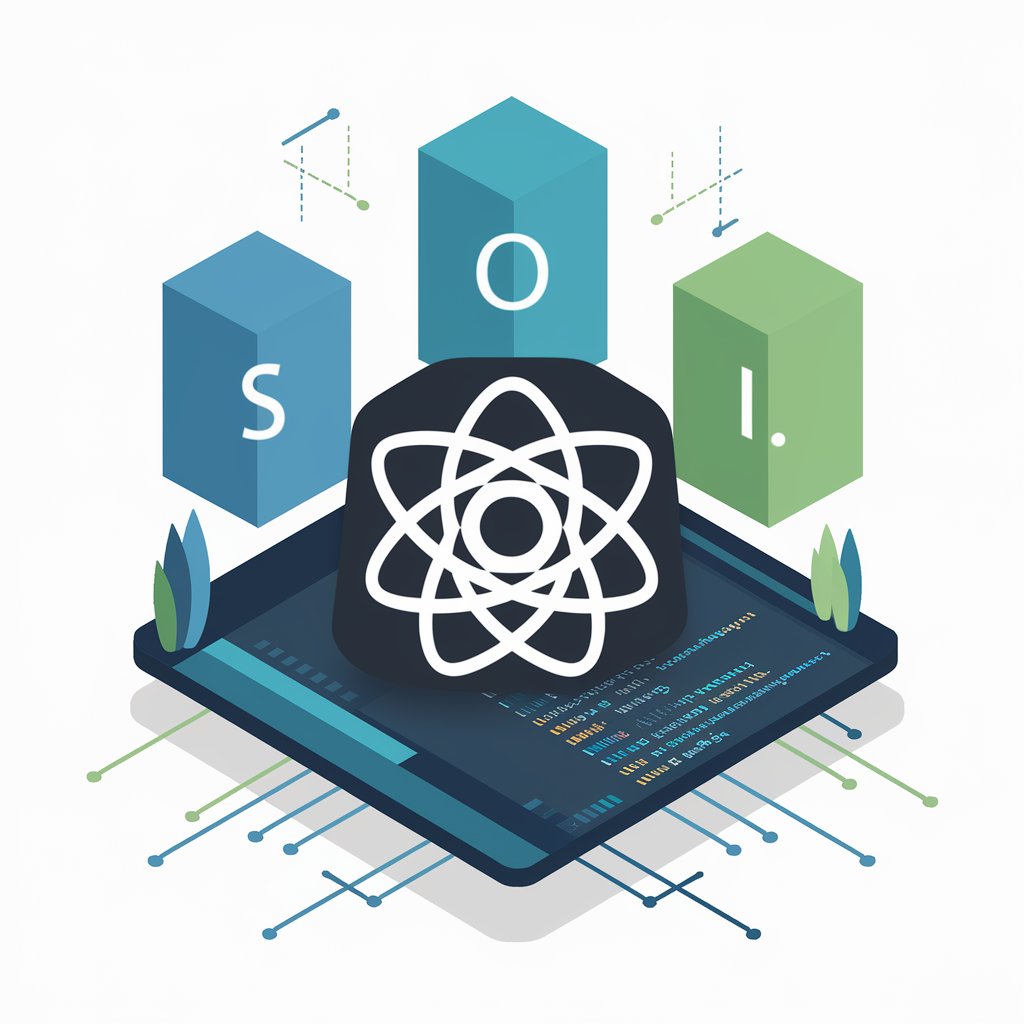
React SOLID Principles - guide on React SOLID principles

Welcome! Let's dive into SOLID principles in React for cleaner code.
Master React design with AI-powered SOLID guidelines
Explore how the Single Responsibility Principle enhances React component modularity by...
Dive into the Open-Closed Principle to extend React components without modifying existing code...
Understand the Liskov Substitution Principle in React to ensure interchangeable components...
Learn how the Dependency Inversion Principle reduces React component coupling through...
Get Embed Code
Introduction to React SOLID Principles
React SOLID principles guide the design and organization of React applications to enhance maintainability and scalability. These principles are adapted from Robert C. Martin's original SOLID principles aimed at improving object-oriented programming. In React, they promote components and systems that are easy to understand, extend, and modify. For instance, the Single Responsibility Principle advocates that a React component should handle only one functionality, thus simplifying the component structure and promoting reusability. The Open/Closed Principle in React can be implemented using higher-order components or hooks to allow components to be extended without modifying their existing source code. Powered by ChatGPT-4o。

Main Functions of React SOLID Principles
Single Responsibility Principle (SRP)
Example
A 'BlogPost' component handles displaying the blog content, while separate components handle comments and likes.
Scenario
This separation simplifies each component, making the system easier to debug and extend, avoiding the monolithic component problem where changes to one aspect, like comment handling, require modifications to the unrelated parts of the component.
Open/Closed Principle (OCP)
Example
A 'Button' component that accepts children and onClick as props, allowing new behaviors through composition without altering the component's internals.
Scenario
Developers can create specialized buttons, like an 'IconButton' or 'SubmitButton', by passing specific icons or behaviors as props, without needing to rewrite the button logic.
Liskov Substitution Principle (LSP)
Example
A 'BaseButton' component is used throughout the application, and new button types like 'IconButton' can replace 'BaseButton' without breaking existing functionality.
Scenario
This ensures that enhancements or specialized versions of a component can be introduced without affecting the places where the original component was used.
Interface Segregation Principle (ISP)
Example
A form handling component that only exposes the necessary props it needs from a form object, rather than the full form data.
Scenario
Forms for different domains, like 'UserForm', 'ProductForm', and 'OrderForm', pass only relevant data to their respective form components, reducing the dependency and increasing maintainability.
Dependency Inversion Principle (DIP)
Example
A 'FetchData' component that uses dependency injection to receive a data fetching function, allowing it to retrieve data from various APIs without depending on specific data fetching implementations.
Scenario
This component can be used across different parts of the application to fetch various types of data, improving code reusability and reducing coupling between components and data sources.
Ideal Users of React SOLID Principles
Senior React Developers
These developers will leverage SOLID principles to architect robust, scalable applications. Their deep understanding helps them create systems that are easy to maintain and extend.
Technical Leads and Architects
Leaders who are responsible for the overall health of the codebase will find these principles essential for guiding their teams towards creating maintainable and scalable software architectures.
Companies Adopting Microservices or Complex Systems
Organizations transitioning to microservices or managing complex systems will benefit from applying these principles to manage dependencies and modularization effectively, ensuring that their systems can grow without becoming unmanageable.

Using React SOLID Principles
1
Visit yeschat.ai to start a free trial, no login or ChatGPT Plus required.
2
Familiarize yourself with the basic concepts of SOLID principles as they apply to software development.
3
Review example React components that demonstrate each of the SOLID principles: Single Responsibility, Open/Closed, Liskov Substitution, Interface Segregation, and Dependency Inversion.
4
Begin refactoring a small React project to apply SOLID principles, starting with the simplest components.
5
Regularly refactor and review code to ensure it stays aligned with SOLID principles as the application evolves.
Try other advanced and practical GPTs
Solid-Friend
AI-powered Solidworks Mastery

Solid-State Electronics I Tutor
Empowering electronics learning with AI

Automotive Engineer
Engineer Smarter Vehicles with AI

Prompt Engineer
Elevate AI interactions with precision-engineered prompts

Workload Engineer
Streamline Your Staffing with AI

EcoStruct Engineer
Building Sustainably with AI

SOLID-Focused Application Designer
AI-powered SOLID Architecture Design

C# SOLID Mentor
Elevate your C# code with AI-powered guidance

Solid Poetic Vision
Turn Emotions into Artistic Poetry

Jarvin - Unity SOLID
Empowering Unity Developers with AI

雷电将军
Eternal wisdom from Teyvat's Shogun

过五关断六将
Empower Your Research with AI-Powered Critique

React SOLID Principles Q&A
What is the Single Responsibility Principle in React?
In React, the Single Responsibility Principle suggests that a component should only have one reason to change, meaning it should manage a single piece of functionality.
How can the Open/Closed Principle be applied in React?
In React, the Open/Closed Principle can be applied by using component composition and props to extend component functionality without modifying the original component code directly.
Can you explain the Liskov Substitution Principle with React components?
The Liskov Substitution Principle in React implies that components should be replaceable with instances of their subtypes without affecting the correctness of the application, typically achieved through consistent props and state management practices.
What does the Interface Segregation Principle mean for React developers?
For React developers, the Interface Segregation Principle means designing components that do not require unnecessary props or states, keeping interfaces within the components minimal and highly relevant.
How is the Dependency Inversion Principle used in React?
The Dependency Inversion Principle in React is often implemented by inverting control, such as passing dependencies into components via props rather than hard-coding them, allowing for better modularity and easier testing.






